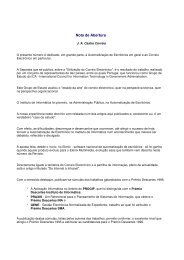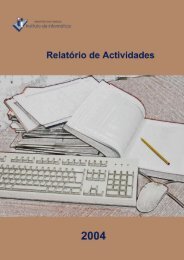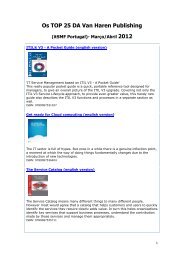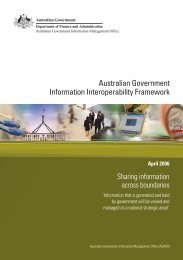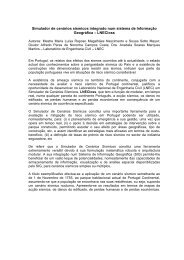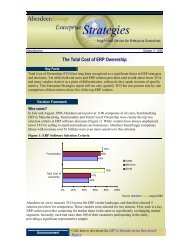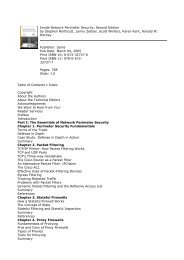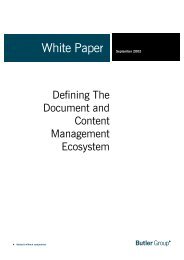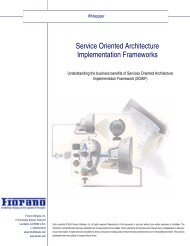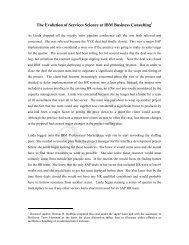OECD Peer Review of E-Government in Denmark - ePractice.eu
OECD Peer Review of E-Government in Denmark - ePractice.eu
OECD Peer Review of E-Government in Denmark - ePractice.eu
Create successful ePaper yourself
Turn your PDF publications into a flip-book with our unique Google optimized e-Paper software.
E-government context<br />
<strong>Government</strong> policy and leadership<br />
<strong>Denmark</strong> has employed ICT <strong>in</strong> government for several decades, and has a long history <strong>of</strong><br />
<strong>in</strong>stitut<strong>in</strong>g policies and programmes focused on effective use <strong>of</strong> this resource. The first notable move<br />
<strong>in</strong> this area was the establishment, <strong>in</strong> 1959, <strong>of</strong> a publicly owned IT services company called<br />
Datacentralen, which provided State government organisations with a wide range <strong>of</strong> data process<strong>in</strong>g<br />
and <strong>in</strong>formation systems design and operations services until its sale to Computer Sciences<br />
Corporation <strong>Denmark</strong> <strong>in</strong> 1996. Public ownership <strong>of</strong> ICT providers is still a major feature <strong>of</strong> the local<br />
government context for Danish e-government, aspects <strong>of</strong> which are exam<strong>in</strong>ed <strong>in</strong> depth <strong>in</strong> Chapter 6.<br />
Dur<strong>in</strong>g the 1970s and 1980s, follow<strong>in</strong>g a pattern common <strong>in</strong> <strong>OECD</strong> countries, <strong>Denmark</strong> focused<br />
ma<strong>in</strong>ly on achiev<strong>in</strong>g efficiencies through process automation. A good example <strong>of</strong> this type <strong>of</strong><br />
development was the <strong>in</strong>troduction, <strong>in</strong> 1970, <strong>of</strong> the Central Income Tax System, which enabled<br />
collection <strong>of</strong> <strong>in</strong>come tax directly from employers, and became <strong>in</strong>creas<strong>in</strong>gly automated over the course<br />
<strong>of</strong> several years. The 1990s brought a shift towards exploit<strong>in</strong>g the power <strong>of</strong> ICT to develop what was<br />
referred to as e-government by the later part <strong>of</strong> the decade. Today the <strong>Government</strong> is pursu<strong>in</strong>g a<br />
vigorous e-government programme spann<strong>in</strong>g the whole <strong>of</strong> the public sector.<br />
There is a favourable environment for development <strong>of</strong> e-government <strong>in</strong> <strong>Denmark</strong>. Past and<br />
present governments have placed strong policy emphasis on mak<strong>in</strong>g the best possible public and<br />
private sector use <strong>of</strong> ICT, <strong>in</strong> pursuit <strong>of</strong> both social and economic goals. As part <strong>of</strong> the <strong>Government</strong>’s<br />
broader focus on the use <strong>of</strong> ICT <strong>in</strong> the economy and Danish society, e-government enjoys good, albeit<br />
<strong>in</strong>direct, political support. While e-government has not <strong>in</strong> itself been a “headl<strong>in</strong>e” policy <strong>of</strong> the<br />
<strong>Government</strong>, it has been clearly positioned as a key element <strong>of</strong> policies aimed at develop<strong>in</strong>g the<br />
Danish <strong>in</strong>formation society, modernis<strong>in</strong>g and <strong>in</strong>creas<strong>in</strong>g the efficiency <strong>of</strong> the public sector, and<br />
improv<strong>in</strong>g the performance <strong>of</strong> the economy. It has also been regarded as an enabler <strong>of</strong> the upcom<strong>in</strong>g<br />
reforms <strong>of</strong> the adm<strong>in</strong>istrative structure <strong>of</strong> the Danish public sector (the “Structural Reform”) that are<br />
based on the recommendations <strong>of</strong> the Danish Commission on Adm<strong>in</strong>istrative Structure.<br />
While <strong>Denmark</strong> does not have a specific m<strong>in</strong>isterial portfolio for e-government, it has placed<br />
overall responsibility for Danish ICT policy (cover<strong>in</strong>g citizens, bus<strong>in</strong>esses and the public sector) with<br />
the M<strong>in</strong>istry <strong>of</strong> Science, Technology and Innovation (MVTU). In 2001, follow<strong>in</strong>g a review <strong>of</strong> the<br />
public sector’s progress <strong>in</strong> develop<strong>in</strong>g e-government, the M<strong>in</strong>istry <strong>of</strong> F<strong>in</strong>ance established both the<br />
Jo<strong>in</strong>t Board <strong>of</strong> e-<strong>Government</strong> and the Danish Digital Task Force to <strong>in</strong>crease the focus be<strong>in</strong>g placed on<br />
overall e-government leadership, plann<strong>in</strong>g and co-ord<strong>in</strong>ation. These bodies now work on<br />
e-government <strong>in</strong> close co-operation with the MVTU.<br />
The Danish political system is characterised by a culture <strong>of</strong> compromise and consensus, and there<br />
are good opportunities for public participation <strong>in</strong> the political process at both the national and local<br />
levels <strong>of</strong> government. This tradition <strong>of</strong> compromise and consensus <strong>in</strong>fluences the culture and operation<br />
<strong>of</strong> the public sector.<br />
Public sector structure and management<br />
The Danish public sector is divided <strong>in</strong>to State and local government. State government comprises<br />
both national and local functions and services. The structure <strong>of</strong> local government is based on a two-tier<br />
system <strong>of</strong> counties and municipalities, with each municipality “belong<strong>in</strong>g” to one <strong>of</strong> the counties.<br />
However, the general rule is that municipalities are not subord<strong>in</strong>ate to counties – both have their own<br />
spheres <strong>of</strong> responsibility.<br />
28



